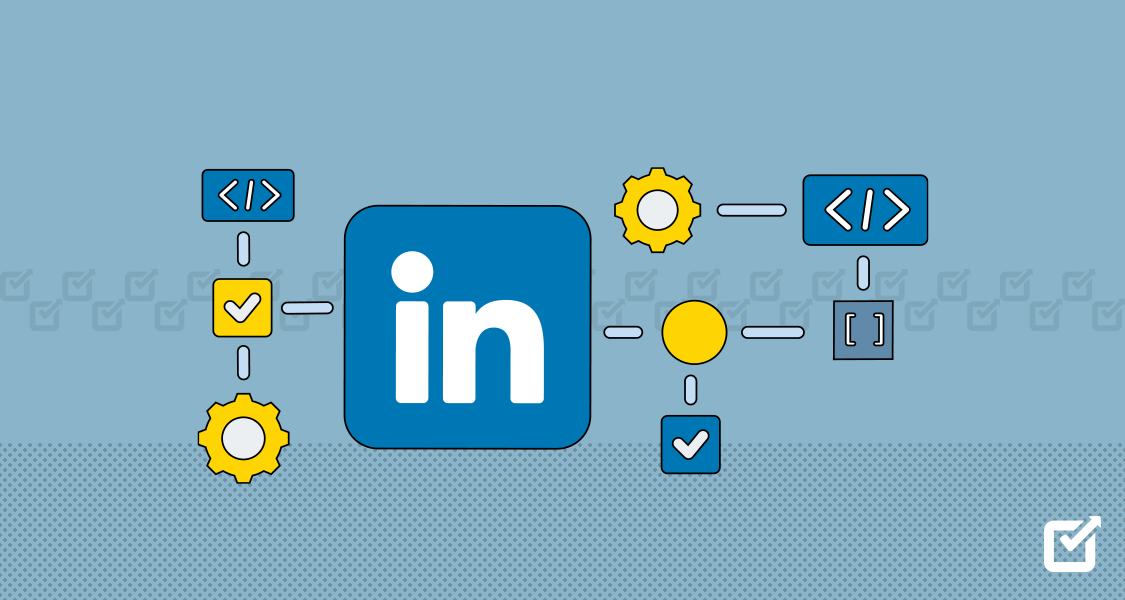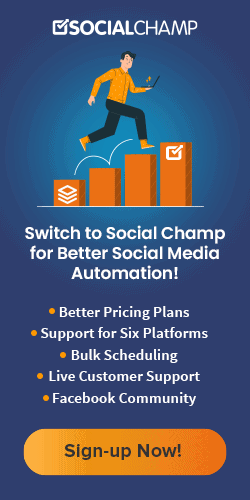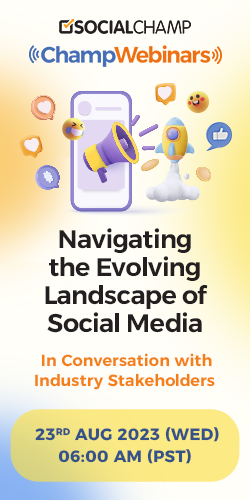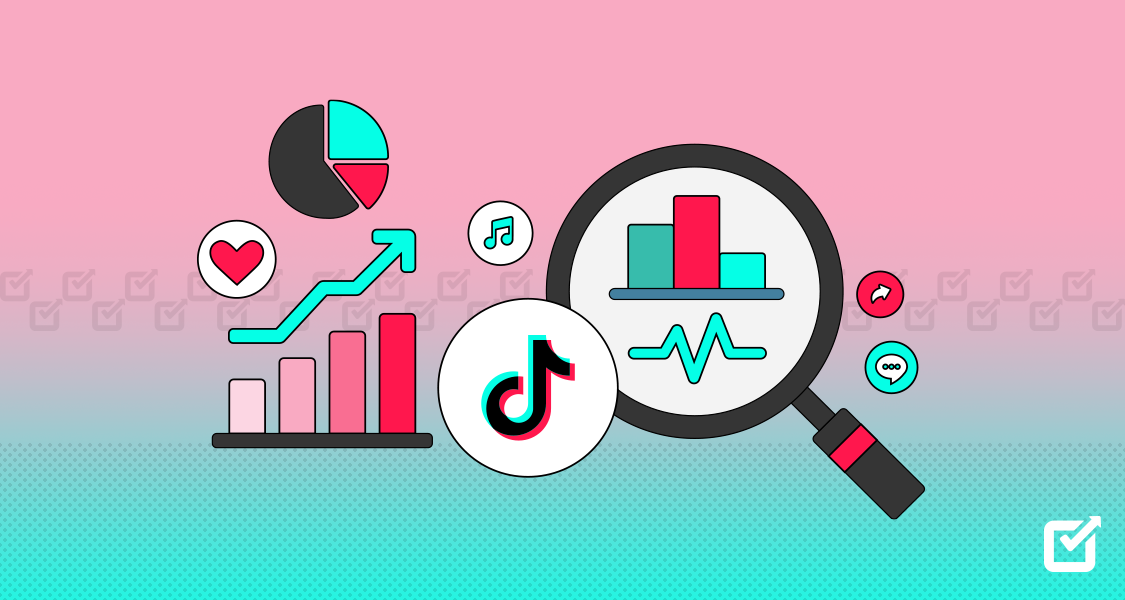Whether you like it or not, LinkedIn is considered an essential channel for any B2B marketer. And like every other social media platform, you need to know & understand the algorithm to master the platform & adopt its continuous changes. This blog is about how and why LinkedIn should be a part of your marketing strategy, how a social media management tool can help you in strengthening your marketing strategy, and how to master the LinkedIn algorithm in 2025.
Table of Content: LinkedIn Algorithm
- LinkedIn Algorithm – Explained
- How Does the LinkedIn Algorithm Work?
- Behind-the-Scene Sneak Peek of LinkedIn Algorithm
- A Quick Recap of Ranking Signals on LinkedIn’s Algorithm
- How to Beat LinkedIn Algorithm in 2025
- How to Use Hashtags on LinkedIn?
- Tips to Outplay With LinkedIn Algorithm in 2025
- In a Nutshell
- Frequently Asked Questions
LinkedIn is that inaccessible cousin of Facebook, which is entirely respectful and formal. As Instagram is all about visuals, LinkedIn is all about connections. Just like Facebook, you can run a company page for connecting with your expected customers on LinkedIn.
For advertisers, entrepreneurs, people, or business visionaries, LinkedIn is a heavenly homestead.
However, there is a thing that separates LinkedIn from other online media–its perfect organic reach. LinkedIn gives you stunning organic reach in a limited period.
LinkedIn Algorithm – Explained
LinkedIn is all fancy and luxurious, attracting all businesses, but at the end of the day, it’s the social media network.
With whopping 900 million users and counting from all around the world, the platform has to process billion posts. All this quick hard work is done for you to ensure you see content that matters to you. Let’s be honest, LinkedIn has somehow a clever algorithm that determines what goes up on your feed, and the best part; the algorithm operates on a large scale. It considers various factors like the topics, people, and types of posts you engage with the most, analyzing how your feed will look like. This helps personalize your feed, making it super interesting for you, so you can come back for more content you need to fuel up yourself.
How Does the LinkedIn Algorithm Work?
The LinkedIn algorithm is not the same as the Facebook algorithm, but some similarities. LinkedIn has implemented a four-step process for content distribution across its network to reduce the chances of spam or inappropriate content. Understanding the steps that LinkedIn takes before cutting (or amplifying) your content’s reach is an integral part of using LinkedIn as a channel for content marketing.
Be More Productive With LinkedIn Scheduling Tool
Easily Manage LinkedIn Company Pages & Profiles With Other Social Networks Using Social Champ
Recently, a visual workflow was published by LinkedIn, which shows how it works. Have a look at this:
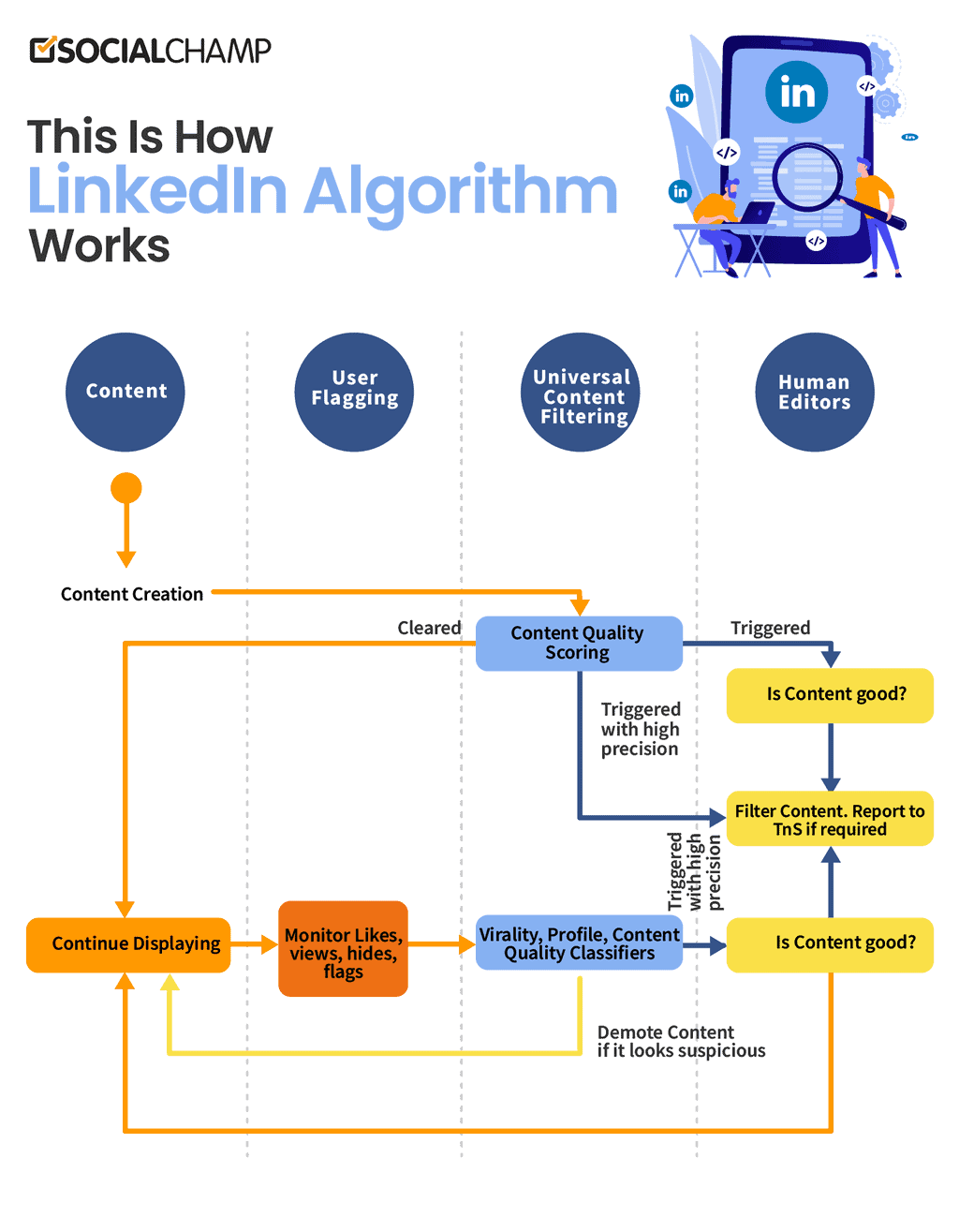
Behind-the-Scene Sneak Peek of LinkedIn Algorithm
Whenever you post an update on LinkedIn, here’s what happens behind the scenes. There are three categories in which they can divide your content. As soon as you post an article or image, the bot puts it in any three types. The aim is to get your post in the “clear” category and to avoid spam. After checking your post’s credibility, the LinkedIn algorithm also determines its usefulness and relevance. And here’s when the fun part begins!
Beginning with Initial Filter
Every time you post an update to LinkedIn (even if it’s an image), a bot immediately places the content into one of three categories:
- Spam
- Low-quality
- Clear
You want to be in the “clear” category. If your content gets put in the “low-quality” category, you may still have hope. It could even move on to the next stages.
Testing Session
The second part is the audience testing process. Once the robots have categorized your post, they send it to your audience to see how popular the content is. At first, they show it to a smaller group of people.
At this phase, your post needs to avoid users “hide” your content from their feeds. Or mark the post as “Report as Spam.”
Pro Tip: Avoid an annoying or offensive post. Don’t over-post. Stop posting irrelevant content. Try to make it focused on the audience and niche of the profile.
How to avoid spam filters?
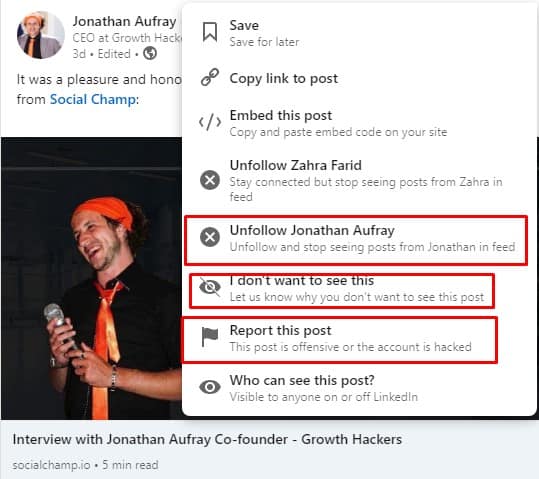 Your post’s initial engagement will decide whether it is good enough to pass the spam filter. Make sure that the users don’t hide your post from their newsfeed or flag it as spam. And to avoid this, you need to consider the following question before posting:
Your post’s initial engagement will decide whether it is good enough to pass the spam filter. Make sure that the users don’t hide your post from their newsfeed or flag it as spam. And to avoid this, you need to consider the following question before posting:
- Are you posting too much content?
- Is this post offensive to any person or entity?
- Are the people in your circle interested in this post?
- Why is this news/update so relevant to post?
- Is it relevant to the profession of your circle?
LinkedIn is more of a professional networking circle, as compared to Facebook or Instagram. People share stuff related to their professional lives more on LinkedIn.
Content Scoring
Consider this phase as the Hogwarts house points! Once placed in front of your friends’ selection, different actions have different weights in the algorithm. For example, a “like” may only have one point, whereas a comment has two points. A “share” shows that the content is popular, so three points. The score of the post will decide its future or its fate. It will either be demoted because it’s low-quality or be shown to more people because it’s high-quality.
Real People Assessment
If you get engagement on your post, the last phase is passed along to “genuine people at LinkedIn.” Who then read every post and decide to send your content out to more people, or whether this is the end of the line. The editors will also send the content to people outside of your network if the content is working well. It will appear in “trending content” on the app, topical content in the news feed, etc.
A Quick Recap of Ranking Signals on LinkedIn’s Algorithm
So basically, LinkedIn’s algorithm relies on three main key ranking signals that determine the order of posts in a user’s feed.
- Personal Connection
- Interest Relevance
- Engagement Probability
Let’s take a brief look at how each signal impacts the ranking of a post.
Personal Connections
The first ranking signal that holds weight in post-ranking is personal connections. LinkedIn shifted its focus to prioritize content from users’ personal connections rather than mega influencers. The algorithm considers factors such as:
- Who the user has worked with or whom it had worked previously.
- Who has interacted with the user previously on the platform.
Once the algorithm analyzes the information, users eventually see posts from those they engage with often and those who are consistently posting on the platform. Additionally, posts from connections with similar interests and skills are based on their LinkedIn profiles.
Relevance
The next ranking signal is the relevance. Basically, LinkedIn has the basic thumb of the rule of valuing high relevance, leveraging the signals to understand a user’s interests. This signal allows the algorithm to measure:
- How much interest does a user take in a certain topic
- How one topic differs from another
- Which type of connections share a user interest
Psst… Creating content that aligns with your target audience’s interests is essential to maximize interest relevance ranking.
Engagement Probability
Last, but not least, LinkedIn relies on another factor: Engagement probability which plays a significant role in post ranking. LinkedIn’s algorithm employs machine learning that assesses:
How likely a user is to engage with a post based on their past interactions and content preferences.
The speed of the post receiving engagement also affects its ranking. Posts that receive quick interactions tend to appear higher in others’ feeds.
How to Beat LinkedIn Algorithm in 2025
Understanding the Algorithm isn’t as hard as you think. So, trending posts (that have gained a lot of engagement) are the first thing you see on your LinkedIn feed. Then, an option lets you sort the posts by ‘Top’ or ‘Relevance.’
Now, how does LinkedIn know what’s relevant to us? The answer is simple. LinkedIn pushes the content based on our recent activities, like our comments, who we follow, etc.
Here are a few tips for mastering the LinkedIn Algorithm in 2025.
Choose Right-Time to Post
Let’s visualize the scenario, with the sun rising, the sleepy-eyed professionals starting their day with a cup of coffee they need to charge themselves. That’s when you know to post a thought-provoking post that ignites their morning inspiration, giving them much-needed motivation.
Or maybe you can try posting in the afternoon when minds are buzzing and fingers are tapping away on keyboards. An ideal time to post on LinkedIn can make all the difference, maximizing your overall engagement on the platform.
What Is the Best Time to Post on LinkedIn in 2025?
Choosing perfect timing to make a post is essential. If you’re posting at 2 a.m., when most of your network is asleep (time-zone nuances aside), your post can be up for hours before receiving likes or comments, no matter how good it is. LinkedIn is a professional network, and most people work from 9 a.m.–5 p.m.
According to another research, the best time to post will depend on the tests you perform. The location, time zones, and people’s daily habits affect when they’re on LinkedIn, which differs in any audience segment.
In fact, 50% of LinkedIn users check their accounts through mobile devices, implying you have as much chance of reaching people after hours as you do during the workday. You can use a LinkedIn scheduling tool to be active at different time zones. Like Facebook or Pinterest, LinkedIn doesn’t offer content scheduling. But, you can use a third-party LinkedIn scheduler to make the most of your marketing efforts.
Related Article: 100+ Twitter Bio Ideas to Strengthen Your Impression in 2025
Acknowledge the Content-Type That LinkedIn Craves
LinkedIn has made things super transparent and clear when it comes to the type of content they want on their platform. You know, the right content accepted by LinkedIn must be authentic and fall into the professional world’s criteria. So, if you want to upload those funny animated Giphy, morning selfies animated GIFs, musical videos, and personal screenshots, put them aside for now.
The LinkedIn algorithm always strives to prioritize content that is beneficial to users’ careers, whether they are business owners or employees. It focuses on timely industry-specific information and offers business growth tips or career insights. You can share various content types, including images, videos, LinkedIn article posts, external webpage links, or simple text updates.
At the end of the day, LinkedIn craves content that adds value to professionals and their aspirations. So, let’s keep it professional, informative, and career-oriented to make the most impact on this platform.
Use the LinkedIn Publisher Tool
Ever tried the mighty LinkedIn publisher tool? If not, then maybe this article is your sign to try it, just in case , you want to outplay the LinkedIn algorithm.
Basically the platform strongly emphasizes the posts created through their Publisher tool. These posts have the opportunity to appear on LinkedIn Pulse, which is now integrated with the homepage feed. The charm of this feature is that it allows users to publish content as individual authors, providing a personal touch. I mean, you and your team have the power to write blog posts using Publisher and share them with your network.
The Editor-in-Chief at LinkedIn explains that the Publisher posts show up in the feed for your connections and followers based on time. So, be sure to follow the next few tips to keep the post circling through the LinkedIn algorithm.
LinkedIn Publisher tool plays a significant role in expanding your reach and establishing your voice as an individual author in the chaotic, competitive digital landscape. So, let your creativity flow and make the most of this powerful feature to captivate your audience on LinkedIn.
Featured Article: “ How to Schedule Facebook Posts Like a Genius!“
How to Use Hashtags on LinkedIn?
Hashtags are also a bigger deal on LinkedIn now. The more you use hashtags on a LinkedIn post, the better it categorizes content and highlights relevant posts to each user. Hashtags are a brilliant way to not only increase your reach but also discover similar content quickly. LinkedIn gives you the option to pin your favorite hashtags. You can pin hashtags related to your industry to see the latest updates on your newsfeed.

Building connections is an essential aspect of LinkedIn. However, who you should add to LinkedIn depends on your branding approach.
Featured Article: How to Promote Your YouTube Channel in 2025
Not Sure How to Leverage LinkedIn Algorithm with Social Champ?
Learn to manage LinkedIn company pages & profiles with creative content from platform tutorials on our YouTube channel
Tips to Outplay With LinkedIn Algorithm in 2025
It is not tricky to get a successful LinkedIn marketing in 2025; all you need is newer ideas to make your content recognized professionally.
Optimize Your Content for Engagement
The content you post on LinkedIn should be optimized according to engagement, and quality. It can have puns or funny jokes to make professionals laugh. Create posts with valuable and career-related tips with relevant industry or company stats. Keep it short and include a link, image, or video. Use hashtags. Your posts can become trending posts on a specific hashtag.
A/B testing with tools and analytics on LinkedIn is essential to monitor the content performance. It is better to keep revising and experimenting until you figure out what works best for your audience (and in your industry) on LinkedIn.
One of the best LinkedIn coaches, Andy Foote, shared his expert advice and answered some frequently asked questions about the LinkedIn algorithm, and explained which type of content performs well on LinkedIn in this blog. According to Andy’s research & study,
“I’ve settled into a routine of mostly posting text plus a picture or text plus a document. I get decent views/engagement. And was buoyed to see that LinkedIn recently added a Documents tab in the activity section.”
Content Scheduling
Content scheduling is one of the most important things here. Timing is everything! You need to post the right content at the right time. LinkedIn management tool like Social Champ allows you to maintain your profiles. These tools are not only time-saving but also give you the best content suggestions & analytics. To do LinkedIn marketing professionally, you need to work professionally with these tools. Social media posting tools will help you in taking the proper steps can get more engagement on posts.
LinkedIn Messaging
A simple way to reconnect is by commenting on updates from people in your network. See an interesting conversation? Add a comment with your thoughts or share a great article you read on 2025 trends with your connections via LinkedIn Messaging.
Use Reactions and Comments Wisely
The first 60 minutes after posting content are the most crucial part of your content marketing success. It’s the ‘Golden Hour’ for your post. If no one reacts to your posts within the 60 minutes of posting, chances are it won’t perform well. The velocity of your post’s engagement depends on the ratio between reach, relevancy, views, reactions, and shares. Try to get 20+ engagements (replies or comments) in the first half.
How?
Notify your employees about the post. Use your internal communication mediums, such as Slack, Trello, or Jira, to inform everyone about the post and ask them to participate.
Comments are the king of engagement. If you want to maximize your reach, you need to react/respond to every comment on your post. Engage with new followers to keep them in a loop.
Use mentions and hashtags. On average, you must use a minimum of 5 hashtags in every post and tag a maximum of 3 LinkedIn users. If you’re sharing someone’s quote or interview, give them credit or inform them by tagging in your post so that they can share it with their followers too.
Focus more on quality rather than the number of your posts. Measure engagement, not views.
Build Your Audience Strategically
Relevance, credibility, followers, and connections play a big part in the LinkedIn algorithm.
It would be best to grow your personal or business audience (or both) on LinkedIn. Ensure your profile is public so more people can find you, add you, and see your posts.
Whether you run a personal profile or a Company Page on LinkedIn, be sure to fill out your profile and Company Page as entirely as possible. And keep them updated. Add connections, encouraging employees to show they work at your company.
Here’s what else you can try:
- Take part in LinkedIn Groups, or host your own.
- Give and receive recommendations.
- Join conversations and be active on the network.
- Promote your LinkedIn profiles and Company pages on your website and in other appropriate spaces.
- Share other users’ posts, and they’ll probably share yours.
LinkedIn is primarily a social network, so it helps to be social. Be kind to others by sharing their posts. Or embedding their videos on your site. These actions increase your profile reach. Plus, if you strive to be a LinkedIn Influencer, making friends on LinkedIn is a good idea. However, Publisher posts get even more exposure outside the homepage feed on LinkedIn. They are shown on your profile and as highlights.
Create an All-Star Profile
It’s time to revamp your LinkedIn profile into a captivating masterpiece. If you want to maximize your profile’s impressions, try optimizing it with relevant keywords that showcase your expertise, accomplishments, and a sprinkle of unique value propositions. Note it down, a well-curated profile is a strong base for LinkedIn success.
Spark Meaningful Connections
Develop a thriving community on LinkedIn by actively engaging with your connections. Respond to comments, ask open-ended questions, and foster genuine discussions. Meaningful conversations deepen relationships and signal to the algorithm that your content is worth promoting. You can run polls to ignite conversations and respond to the comments instantly.
Hashtags Make a Splash
Be at the top of the LinkedIn feeds and improve the overall discoverability of your posts by strategically incorporating relevant hashtags. These little powerhouses categorize your content, making it easier for users to find and engage. Choose hashtags that are popular within your industry and align with your content. However, avoid using spammy ones.
The Rhythm of Consistency
Maintain a consistent posting schedule to keep your presence active and relevant. Regularly share valuable content to establish yourself as a reliable source of industry insights. Consistency builds credibility and helps you stay on top of the algorithm’s radar. You can use social media management tools like Social Champ to streamline your daily workflow.
Related Article: What is the Best Time to Post on Social Media in 2025
In a Nutshell
Once you understand the LinkedIn algorithm & know how it works, you will understand why so many people who once had thousands of likes on their posts now complain that they are only generating a handful. It’s because the tactics and strategies that they were using are now being classified as low-quality content.
Engagement is critical to the algorithm and depends on relevancy, the reach of your network, the times they are checking LinkedIn, and your credibility with that audience. Using the LinkedIn Publisher platform is a good idea.
Sometimes, you can republish posts from your blog, but not always, and only when you know what you’re doing while reciprocity wins on any social media strategy, including LinkedIn. Use analytics and experiments to refine your marketing strategy.
Start experimenting with posts on LinkedIn! Start spending time on the LinkedIn feed!
Happy Linking! Stay Connected!
Frequently Asked Questions
- What Is the Algorithm of LinkedIn?
Ans: The algorithm of LinkedIn determines the post and analyzes which content should go up on the user’s feed. - How does the LinkedIn Algorithm Work?
Ans: LinkedIn algorithm relies on important factors and determines who can see what is being posted on the platform, determining the ranking factor. - How Do I Get Around the LinkedIn Algorithm?
Ans: Here’s how you can get around the LinkedIn algorithm- Know what your audience wants
- Post at the right time
- Keep your posts professional
- Avoid Spammy Content & Hashtags
- What Are the Changes in the LinkedIn Algorithm in 2025?
Ans: LinkedIn algorithm is constantly changing. Relevancy, recency, quality, and engagement are the major algorithm factors.
